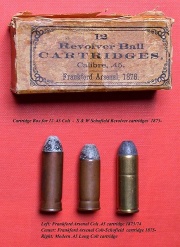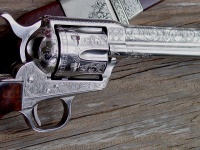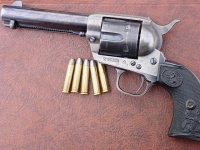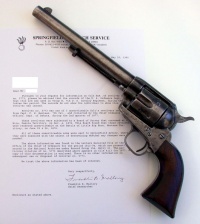Colt Single Action Army
| Colt Peacemaker | |
|---|---|
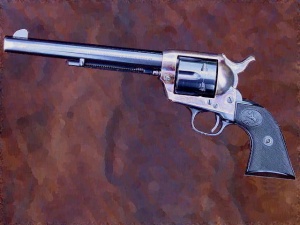
| |
| Second Generation Colt Single Action Army | |
|
| |
| Type | revolver |
| Land of Origin | United States |
| Specifications | |
| Length | 11" (279 mm - with 5½" barrel); 13" (318 mm - with 7½" barrel) |
| Weight | 1,048 g (with 7½" barrel) |
| Cartridge | .45 Colt, .44-40 WCF, .38-40 WCF, .32-20 WCF and many others, including .22LR, .38Spl, .357Magnum, .44Spl (commercial models) |
| Action | single-action |
| Chambers | 6 |
|
| |
| Service History | |
| In service | 1873–1892 (Artillery Model - 1902) |
| Used by | United States |
| Wars | Indian wars, Spanish-American war, Philippine-American War |
| Production History | |
| Designer | Colt's Manufacturing Company |
| Design Date | 1873 |
The Colt Single Action Army has been offered in over 30 different calibers and various barrel lengths. Its overall appearance has remained consistent since 1873. Colt has discontinued its production twice, but brought it back due to popular demand. The pistol was popular with ranchers, lawmen, and outlaws alike, but current models are mostly bought by collectors and reenactors. Its design has influenced the production of numerous other models from other companies.
[edit] History
Bound by the Rollin White patent (#12,648, April 3, 1855) and not wanting to pay a royalty fee to Smith & Wesson, Colt could not begin development of bored-through revolver cylinders for metallic cartridge use until April 4, 1869.[1] The Colt Single Action Army was designed for the US government service revolver trials of 1873 by Colt's Patent Firearms Manufacturing Company and adopted as the standard military service revolver. Its original moniker was the "New Model Army Metallic Cartridge Revolving Pistol".[2]
The very first production Single Action Army, serial number 1, thought lost for many years after its production, was found in a barn in Nashua, New Hampshire in the early 1900s.[3]
The .45 Colt cartridge was of center fire design containing charges of up to 40 grains (2.6 g) of fine grained black powder and a 255-grain (16.5 g) blunt round nosed bullet. Relative to period cartridges and most later handgun rounds, it was quite powerful in its full loading.[2]
The Colt Single Action Army revolver replaced the Colt 1860 Army Percussion revolver and remained the primary US military sidearm until 1892 when it was replaced by the .38 Long Colt caliber Colt Model 1892, a double action revolver with swing-out cylinder. By the end of 1874, serial no. 16,000 was reached; 12,500 Colt Single Action Army revolvers chambered for the .45 Colt cartridge had entered service and the remaining revolvers were sold in the civil market.
[edit] Variations 1873–1941
The Single Action Army became available in standard barrel lengths of 4¾", 5½" as well as the Cavalry standard, original 7½". The shorter barreled revolvers are sometimes called the "Civilian" or "Gunfighter" model (4¾") and the Artillery Model (5½"). There was also a variant with a sub 4" barrel, without an ejector rod unofficially referred to as the "Sheriff's Model", "Banker's Special", or "Storekeeper"[4]
From 1875 until 1880 Colt marketed a Single Action revolver in the .44 rimfire Henry caliber in a separate number range from no. 1 to 1,863 .[5]
A "Flattop Target Model" was listed in Colt's catalogs from 1890 to 1898. Colt manufactured 914 of these revolvers with a frame which was flat on the top and fitted with an adjustable leaf rear sight. The front sight consisted of a base with a interchangeable blade.
In 1896, at serial number 164,100, a springloaded base pin latch replaced the cylinder pin retaining screw and by 1900, at serial number 192,000, the Colt Single Action was certified for use with smokeless powder.[3] In 1920, larger, highly visible sights replaced the original thin blade and notch. The revolvers remained essentially unchanged from that point until cessation of manufacture at the beginning of World War II.[4]
[edit] 45 Colt cartridge variations
The first Colt Single Action Army revolvers were manufactured in .44 American caliber for the 1872 government trials, as the .44 American was the cartridge used in the 1000 Smith & Wesson Model 3 revolvers issued to the troops. After the tests, the Colt was declared the superior revolver and the government specified that a .45 caliber cartridge would be required. With the adoption of the Colt Single Action Army revolver in 1873, the service cartridges were Copper cased .45 center fire Benét inside primed “Colt’s Revolver Cartridges” loaded with 30 grains of black powder and an inside lubricated bullet of 250 grain. They were manufactured at Frankford Arsenal, Philadelphia, PA, through 1874. In 1875, the cartridge was shortened so that it would also function in the newly adopted S & W Schofield revolver. It was designated “Revolver Cartridge” and loaded with 28 grains of black powder and a bullet of 230 grain. The Bénet primed cartridges were manufactured until 1882 and then replaced by reloadable cartridges with brass cases and external primers.
The original .45 Colt black powder load of 40 grains propelled the 250-255 grain bullet at a nominal 970 feet per second (300 m/s). Authors John Taffin and Mike Venturino have demonstrated that modern black powder loadings of the 45 Colt cartridge frequently achieve velocities in the vicinity of 1,000 feet per second (300 m/s) with the 7½" "cavalry" barrel length, even though modern solid-head cases make it impossible to load a full 40 grains.[6][7] Specifications for 20th-century smokeless loads set velocity with a 255-grain (16.5 g) round-nosed flat-point bullet at 870 feet per second (270 m/s) providing 429-foot-pound-force (582 J) energy.[8]
The current version of the 45 Colt differs from the original cartridge case in that the rim is significantly larger (with a groove immediately above it) and the internal aspect of the primer pocket is surrounded by solid brass instead of protruding into the powder chamber. This "solid head" case is stronger and resists deformation of the primer pocket. Some commercial and custom revolvers and single-shot pistols (such as the Ruger Blackhawk, T/C Contender and others) employ high-pressure loads that are dangerous in the Single Action Army and other vintage arms chambered for the 45 Colt cartridge, especially 19th-century "pre-smokeless" revolvers which should be fired (if at all) only with black powder or light smokeless loads.
Prior to World War II, the 45 Colt used a groove diameter of .454"; post-WW II production adopted the .452" groove diameter of the 45 ACP. Handloaders should slug their barrels to determine the correct groove diameter, and size cast bullets accordingly.
[edit] Calibers
By 1878 the Colt SAA was being offered from the factory in additional calibers for civilian and foreign military sales. Many were sold in .44-40 Winchester Center Fire (WCF), introduced in 1878 to allow cross-compatibility with the Winchester '73 lever action rifle; this model was called the "Colt Frontier Six-Shooter" which was etched and later roll-stamped on the left side of the barrel. Additional period calibers for the SAA included .38-40 Winchester (38 WCF) introduced in 1884, the .32-20 Winchester (32 WCF) introduced in 1884, the .41 Colt introduced in 1885, the .38 Long Colt in 1887, the .38 Special and the .357 Magnum in the 20th Century. Some of the separately-serialized .44 Henry rimfire revolvers were rechambered to .22 rimfire after 1885. The SAA at one time or another was offered in dozens of calibers from .22 rimfire to .476 Eley, though the .45 Colt has always been the most common. A scaled-down .22 rimfire version called the Scout or Frontier Scout was available in the late 20th Century.
[edit] First-, second-, third-generation Colt Single Action and major calibers
From 1873 through 1940 (with small numbers assembled during and after World War II, the so called "Pre-War, Post-War" model), production of the Colt Single Action Army reached 357,859. This is identified as the "Pre War" or "First Generation" of the model. Calibers, at least thirty in all, ranged from .22 rimfire through .476 Eley with approximately half or 158,884 (including Bisley and Flat Top Target variations), were in the .45 Colt chambering. The next most prevalent were the .44-40 Winchester Center fire (WCF) at 71,392; 38-40 (38 WCF) at 50,520; 32-20 Winchester (32 WCF) at 43,284 and, the 41 Colt at 19,676.[3]
Second Generation Colt Single Action Army revolvers were produced from 1956–1974 and carried serial numbers in the range of 0001SA to 73,205SA. About 400 of the Second Generation Colt Single Actions were factory engraved by Colt's, the factory engravers of the period were Alvin Herbert, Earl Bieu, Dennis Kies, Robert Burt and Leonard Francolini. One of the most sought-after engravers who have worked on Colt revolvers was Alvin White and the shop of A. A. White Engravers.
The Third Generation began in 1976 characterized by a change in barrel thread pitch and a solid cylinder bushing replacing the removable/replaceable part from the first and second generations. This Generation ran until 1982 as a limited-issue product with the serial number range of SA80,000 to SA99,999. In 1994, production resumed with the increase in popularity of "Cowboy Action Shooting". These models are known either as "Late Third Generation" or sometimes Fourth Generation with the serial number convention changing yet again starting with S02001A and continuing with the "S" prefix and "A" suffix to 2009. Colt currently offers the Single Action Army in one of two finishes: either an all-nickel or blued with color case-hardened frame; in the traditional three barrel lengths: 4¾", 5½" and 7½"; and six chamberings: 32-20, 38-40, 44-40, .38 Special, 357 Magnum or 45 Colt; a total of 36 variations.
[edit] Operation
The Single Action Army action is a refinement of the earlier Colt percussion revolvers and the Colt 1871 cartridge revolver. The cylinder is mounted on a central axis and operated by a hand with a double finger whose more extended action allowed the cylinder-ratchet to be cut in a larger circle, giving more torsional force to the cylinder. Three notches on the face of the hammer engage the sear portion of the trigger, affording four basic hammer positions. The hammer when fully lowered rests within the frame. Drawn slightly to the rear, the hammer engages the safety notch of the sear and holds the firing pin out of direct contact with a chambered cartridge. Like the earlier percussion revolvers, the Single Action Army was designed to allow loading of all of the chambers. The safety notch replaced pins on the rear of the percussion revolver cylinders which served the same purpose as the safety position by preventing hammer contact with the primer/percussion cap. However, many users adopted the practice of leaving one empty chamber under the hammer because a sharp blow could damage the mechanism and allow the fully loaded revolver to fire. This practice is now universally recommended.[9] Drawn back about half way, the hammer engages the second notch. This cams the cylinder bolt out of engagement and allows the cylinder to rotate for loading. Fully cocked, the revolver is ready to fire. Cartridge ejection is via the spring-loaded rod housed in a tube on the right side of the barrel.
The loading sequence is as follows:
1. Place the revolver on half-cock and open the loading gate to the side;
2. Load each chamber in sequence (original), setting the hammer in the safety notch when finished; or (safe and prudent method) load one chamber, skip the next, load the remaining four chambers, close the loading gate, draw the hammer to full cock and lower fully, making sure that the firing pin is over the empty chamber.
3. Firing the revolver is accomplished by drawing the hammer to full cock and pulling the trigger. The hammer must be manually cocked for each shot.
It is possible to fire the SAA rapidly by holding down the trigger and "fanning" the hammer with the other hand. While this is often shown in movies, it is inaccurate and unsafe and should not be attempted; it also can damage the revolver mechanism and cylinder, requiring expensive replacement. The U.S. Fire Arms Safety and Instructional Manual for Single Action Firearms describes safe handling procedures and user responsibility.[10]
[edit] The Colt Single Action Army in the U.S. Army
All original, good condition, U.S. Cavalry and Artillery Single Action Armies (those produced between 1873 and 1891) are among the most valuable to the collector. Especially valuable, often going for well over $10,000, are the OWA (Orville Wood Ainsworth) and the rare Henry Nettleton inspected Single Action Army Colts. The OWA Colt refers to the earliest issued Single Action Army guns which were inspected by Orville W. Ainsworth. Ainsworth was the ordnance sub-inspector at the Colt factory for the first 13 months (Oct. 1873 to Nov. 1874) of the Single Action Army's production. It was Ainsworth who inspected the Colts used by Col. G.A. Custer's 7th Cavalry at the Battle of the Little Bighorn. The number range of possible Little Bighorn Colts is 4500 - 7527.[3]
Henry Nettleton was the U.S. Principal Sub-inspector in 1878 at the Springfield Armory. Second only to the OWA Colts, Nettleton Colts are prized by serious collectors. Both the Nettleton and OWA Colts have the cartouche (OWA or HN) on the left side of the wood grip.[11]
By the mid 1870s, the Army had purchased a significant number of Smith and Wesson Schofield revolvers chambering a shorter .45 round.[1] Logistical problems arose because the ammunition was not interchangeable. The Colt revolvers would accept the shorter round but not vice versa.[1] For a time, the Government stopped orders for the longer Colt cartridge and used the Smith and Wesson round exclusively. The S & W Schofield was soon retired and sold to the civil market.[1]
The largest group of U.S.Colt Cavalry revolvers was inspected by David F. Clark, his D.F.C. cartouche will be encountered on revolvers inspected from 1880 to 1887.[3]
During the year 1893, the .45 U.S. Colt Single Action Army revolvers were retired by the Cavalry and replaced by the .38 caliber Colt Model 1892 Double Action Army revolver. The .45 Single Action Army revolvers were still standard issue to the Infantry, Artillery and other branches of the U.S. Army.
In 1895-96, the Government returned 2000 SAA revolvers to Colt’s to be refurbished; 800 were issued to the New York Militia with the 7 ½” barrel and 1200 were altered to a barrel length of 5½". In 1898, 14 900 of the SAA revolvers were altered the same way by the Springfield Armory. The original records of the War Department do refer to these revolvers with the shortened barrel as the “Altered Revolver”. The name “Artillery” is actually a misnomer, maybe because the Light Artillery happened to be the first units to be armed with the altered revolver.
The Artillery Single Actions were issued to the Infantry, the Light Artillery, the Volunteer Cavalry and other troops because the standard issue .38 caliber Colt M 1892 double-action revolver was lacking stopping-power. For that reason, the .45 Artillery SAA Revolvers were used successfully by front troops in the Spanish-American War and the Philippine-American War. Theodore Roosevelt's Rough Riders charged up San Juan Hill wielding the 45 cal. Artillery Model.
The Artillery Model usually had mixed numbers. It can be identified by the U.S. on the frame, the inspector's stamps on different parts (such as a tiny A for Orville W. Ainsworth, DFC, HN, RAC for later inspectors and K for replacement parts) and the cartouche of Rinaldo A. Carr (RAC), the inspector who inspected the refurbished guns, on the grip.
[edit] The Colt Frontier Six Shooter
The Colt Frontier or Frontier Six-Shooter was a Colt's 1873 "Model P" type revolver, manufactured in .44-40 Winchester caliber instead of .45 Colt (in which configuration it was called the Single Action Army), so as to be cross-compatible with Winchester Model 73 ammunition. Production began 1877. Colt Frontier Six-Shooter was the actual name of the Colt pistol model, and this was acid-etched on the left side of the barrel. After 1889, the legend was roll-stamped until 1919, when the caliber designation ".44-40" was added. Later Colts 1878 Double Action Army Model also wore this designation on the barrel when chambered in 44 Colt/44-40 Winchester. The Bisley 1895 Model was the final Colt to wear the Frontier Six Shooter designation.
In the last half of the 19th Century it was very common for an individual to own a long gun (rifle or carbine) and a revolver. The users of the .44-40 Winchester cartridge in the Far West appreciated the convenience of being able to carry a single caliber of ammunition which they could fire in both revolver and rifle. The Colt Frontier Six Shooter Revolver and the Winchester Model 73 or the Winchester Model 92 in .44-40 WCF caliber were one of the most common combinations seen in "the Old West".
[edit] The Bisley model
The Colt Bisley was introduced in 1894 as a target pistol. The name Bisley came from the famous firing range in Bisley, England.[12] The Bisley Colt can be distinguished in the longer grip, the wider hammer spur and the wide trigger.[12] The distinguishing feature of the Target Models is the top strap, which is flat and fitted with a sliding rear sight adjustable for windage only.[12] The front sight is a removable blade, which fits in the slotted base attached on the barrel. The revolvers were supplied with different blades for elevation.[12]
The Bisley mainspring is longer than the SAA mainspring and the two are not interchangeable; it is attached to the hammer with a stirrup via a forked upper end. The serial numbers are stamped on the frame, the back strap and the trigger guard strap; at the end of production with tiny dies.[13]
Bisleys were serial numbered in the range of 156300-331916, in the same sequence as the Single Action Army.[12] All Bisleys after No. 161,376 had "BISLEY MODEL" with the caliber stamped on the left side of the barrel, which is rare for older Colt revolvers.[12] The most common calibers were the .32-20, the .38-40, the .45 Colt, the .44-40 the .41 Colt and the British calibers .450 Eley and .455 Eley.[12] A total number of 44,350 were manufactured. The production of the Bisley was terminated in 1912, but the serial No. 331916 was shipped after the 1st World War.[12] Most Bisley Standard Model Revolvers were shipped to a United States address, not for target shooting but for self-defense because the grip and hammer were ideal for fast shooting.[4][12]
[edit] Engraving
Colt engraved less than one (1) percent of its first generation production of the Single Action Army revolver, which makes these engraved models extremely rare and valuable with collectors.[3] Engraved pieces were often ordered by or for famous people of the day, including lawmen, heads of state, and captains of industry.[14] This tradition began with the founder, Sam Colt, who regularly gave such examples away as a means of publicity for Colt.
Colt employed a number of highly skilled engravers, many of whom were highly-trained artisans who immigrated to America from Europe.[14] These artisans were also known for inlaying gold, silver, and precious stones in their work. Many of these engraved pieces were adorned with stocks made of ivory or pearl with engraving and inlays too.
[edit] Legacy
The power, accuracy and handling qualities of the Single Action Army made it a popular sidearm from its inception and well into the 20th century. Such notable old west personalities as Wyatt Earp and William Barclay 'Bat' Masterson favored these revolvers with Earp's elusive and possibly apocryphal "Buntline Special" Colt Buntline gaining fame in the somewhat fictionalized Earp biography, Frontier Marshal, by Stuart N. Lake.[4] An order for a somewhat customized Single Action Army from Masterson remains in the Colt archives.[3] The association with the history of the American West remains to the present century and the revolvers remain popular with shooters and collectors. Famed British adventurer and soldier T. E. Lawrence ("of Arabia") had a special fondness for this weapon because it saved his life during one of his pre-World War I trips to Mesopotamia; he was attacked by an Arab bandit who stole the gun and tried to shoot Lawrence. However, the bandit was unable to fire the weapon because he did not understand the revolver's single-action mechanism. Lawrence thereafter always carried one of these weapons for good luck.[15] US Army General George S. Patton, who began his career in the horse-cavalry, carried a custom-made SAA with ivory grips engraved with his initials and an eagle, which became his trademark. He used it during the Mexican Punitive Expedition of 1916 to kill two of Pancho Villa's lieutenants, and carried it until his death in 1945 shortly after the end of World War II.[16]
In the early and mid-20th century, original Peacemakers lacking historical provenance and not in pristine condition were not particularly valuable. They served as raw material for early enthusiasts such as Elmer Keith, Harold Croft and R. F. Sedgley who modified the revolvers to enhance performance and experimented with more effective ammunition.[9][17] At the beginning of the 21st Century, first and second generation SAA's are highly regarded as collectors' items and often considered too valuable to shoot.
After the 2nd World War, new interest in the SAA started and firearms enthusiast William R. Wilson recognized the need and the opportunity. In 1953 Wilson founded the Great Western Arms Company to produce an almost-exact clone of the old Colt SAA for television and movie westerns. The Great Western revolvers were 100% manufactured in Los Angeles.
Later Colt editions are more common, and various copies and near-copies of the revolver are made by A. Uberti of Italy, now owned by the P. Beretta firm, and others. American manufacturers include Colt Manufacturing Company, which still retains the model in its catalog. U.S. Fire Arms Mfg. Co. builds several variations that are true to the original first and second generation specifications. STI International has introduced a very precisely made Single Action Army with a modified hand/spring assembly designed to last longer than the originals.
The Single Action Army is the precursor and inspiration for modern sporting revolvers from John Linebaugh, Freedom Arms, Ruger, Cimarron, and others.[16]
[edit] References
- ↑ 1.0 1.1 1.2 1.3 Hartink, A.E. (2002). The Complete Encyclopedia of Pistols and Revolvers. Edison, New Jersey: Chartwell Books, Inc. pp. 447. ISBN 9780785815198.
- ↑ 2.0 2.1 Taylor, Chuck (1981). Complete Book Of Combat Handgunning. Boulder, CO: Paladin Press. p. 200. ISBN 9780873643276.
- ↑ 3.0 3.1 3.2 3.3 3.4 3.5 3.6 Wilson, R.L. (1985) Colt: An American Legend, New York City: Abbeville Press.
- ↑ 4.0 4.1 4.2 4.3 Adler, Dennis (2008). Colt Single Action: From Patersons to Peacemakers. Edison, New Jersey: Chartwell Books. pp. 309. ISBN 978-0785823056.
- ↑ Cochran, Keith. Colt Peacemaker Encyclopedia.
- ↑ Taffin, John. (2002) Big Bore Handguns, Iola, WI, Krause Publications.
- ↑ Venturino, Mike (2008). "The Other Old West Sixguns". Guns Magazine 23 (5): 48.
- ↑ Smith, WHB (1968). Book of Pistols and Revolvers. Harrisburg, PA: Stackpole Books.
- ↑ 9.0 9.1 Keith, Elmer (1955). Sixguns by Keith, New York, Bonanza Books.
- ↑ see U.S. Fire Arms Mfg. Co. Safety and Instruction Manual for single action firearms, retrieved on 8 September 2008.
- ↑ "Henry Nettleton" is a trademark of U.S. Fire Arms Mfg. Co., which manufactures replicas of government inspected guns.
- ↑ 12.0 12.1 12.2 12.3 12.4 12.5 12.6 12.7 12.8 Flayderman, Norm (2001). Flayderman's Guide to Antique American Firearms... and their values. Iola, WI: Krause Publications. p. 669. ISBN 0-87349-313-3.
- ↑ Wilson, R.L. (1987) The Colt Heritage, New York City: Simon & Schuster.
- ↑ 14.0 14.1 Wilson, R.L. (1995). Steel Canvas: The Art of American Arms. Chartwell Books. ISBN 0-7858-1891-X.
- ↑ Thomas, Lowell (1924). With Lawrence In Arabia. London: Hutchinson & Co. pp. 316.
- ↑ 16.0 16.1 Wilson, RL (1992). Peacemakers: Arms and Adventure in the American West. Edison, New Jersey: Chartwell Publications. p. 392. ISBN 978-0785818922.
- ↑ Bowen, Hamilton (2001) The Custom Revolver, Louisville, Tenn.
